steering FIAT STILO 2006 1.G User Guide
[x] Cancel search | Manufacturer: FIAT, Model Year: 2006, Model line: STILO, Model: FIAT STILO 2006 1.GPages: 274, PDF Size: 4.76 MB
Page 62 of 274
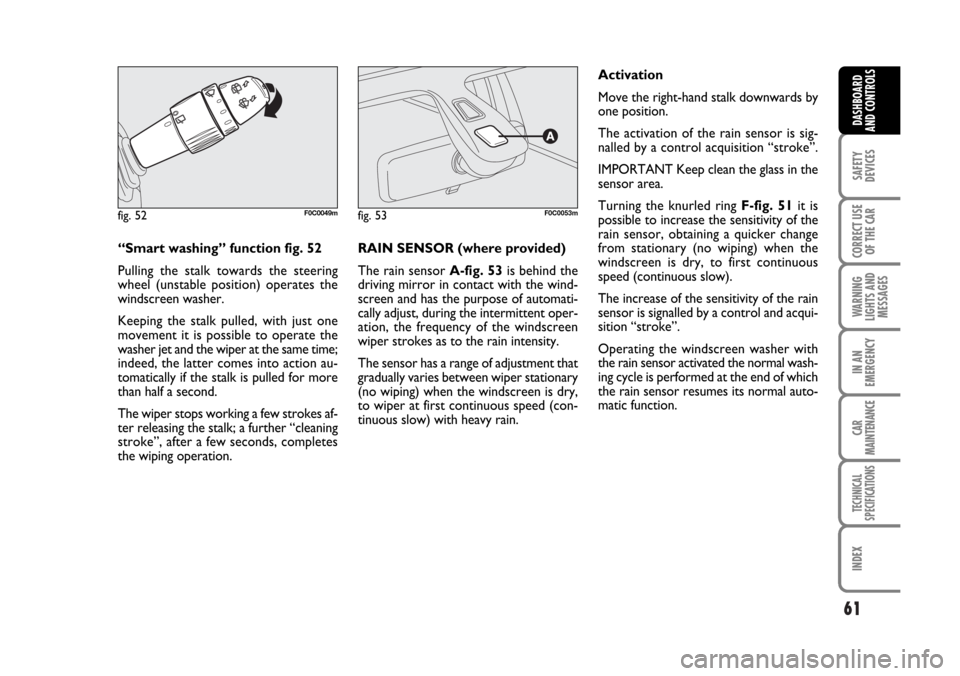
61
SAFETY
DEVICES
CORRECT USE
OF THE CAR
WARNING
LIGHTS AND
MESSAGES
IN AN
EMERGENCY
CAR
MAINTENANCE
TECHNICAL
SPECIFICATIONS
INDEX
DASHBOARD
AND CONTROLS
“Smart washing” function fig. 52
Pulling the stalk towards the steering
wheel (unstable position) operates the
windscreen washer.
Keeping the stalk pulled, with just one
movement it is possible to operate the
washer jet and the wiper at the same time;
indeed, the latter comes into action au-
tomatically if the stalk is pulled for more
than half a second.
The wiper stops working a few strokes af-
ter releasing the stalk; a further “cleaning
stroke”, after a few seconds, completes
the wiping operation.RAIN SENSOR (where provided)
The rain sensor A-fig. 53is behind the
driving mirror in contact with the wind-
screen and has the purpose of automati-
cally adjust, during the intermittent oper-
ation, the frequency of the windscreen
wiper strokes as to the rain intensity.
The sensor has a range of adjustment that
gradually varies between wiper stationary
(no wiping) when the windscreen is dry,
to wiper at first continuous speed (con-
tinuous slow) with heavy rain.Activation
Move the right-hand stalk downwards by
one position.
The activation of the rain sensor is sig-
nalled by a control acquisition “stroke”.
IMPORTANT Keep clean the glass in the
sensor area.
Turning the knurled ring F-fig. 51it is
possible to increase the sensitivity of the
rain sensor, obtaining a quicker change
from stationary (no wiping) when the
windscreen is dry, to first continuous
speed (continuous slow).
The increase of the sensitivity of the rain
sensor is signalled by a control and acqui-
sition “stroke”.
Operating the windscreen washer with
the rain sensor activated the normal wash-
ing cycle is performed at the end of which
the rain sensor resumes its normal auto-
matic function.
fig. 52F0C0049mfig. 53F0C0053m
Page 95 of 274
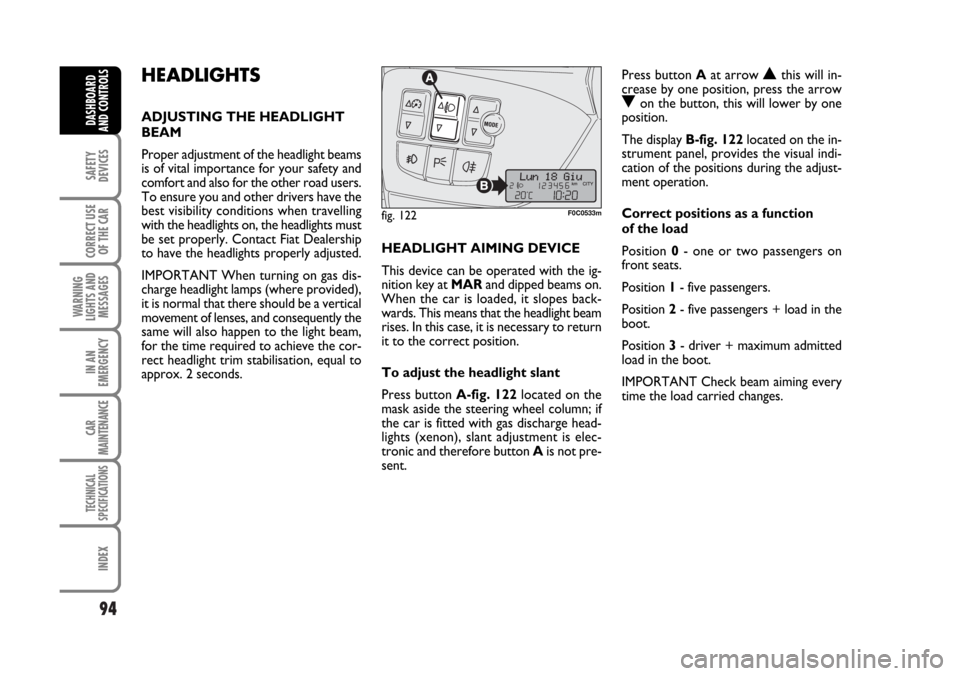
94
SAFETY
DEVICES
CORRECT USE
OF THE CAR
WARNING
LIGHTS AND
MESSAGES
IN AN
EMERGENCY
CAR
MAINTENANCE
TECHNICAL
SPECIFICATIONS
INDEX
DASHBOARD
AND CONTROLS
HEADLIGHTS
ADJUSTING THE HEADLIGHT
BEAM
Proper adjustment of the headlight beams
is of vital importance for your safety and
comfort and also for the other road users.
To ensure you and other drivers have the
best visibility conditions when travelling
with the headlights on, the headlights must
be set properly. Contact Fiat Dealership
to have the headlights properly adjusted.
IMPORTANT When turning on gas dis-
charge headlight lamps (where provided),
it is normal that there should be a vertical
movement of lenses, and consequently the
same will also happen to the light beam,
for the time required to achieve the cor-
rect headlight trim stabilisation, equal to
approx. 2 seconds.HEADLIGHT AIMING DEVICE
This device can be operated with the ig-
nition key at MARand dipped beams on.
When the car is loaded, it slopes back-
wards. This means that the headlight beam
rises. In this case, it is necessary to return
it to the correct position.
To adjust the headlight slant
Press button A-fig. 122located on the
mask aside the steering wheel column; if
the car is fitted with gas discharge head-
lights (xenon), slant adjustment is elec-
tronic and therefore button Ais not pre-
sent.Press button Aat arrow
Nthis will in-
crease by one position, press the arrow
Oon the button, this will lower by one
position.
The display B-fig. 122located on the in-
strument panel, provides the visual indi-
cation of the positions during the adjust-
ment operation.
Correct positions as a function
of the load
Position 0- one or two passengers on
front seats.
Position 1- five passengers.
Position 2- five passengers + load in the
boot.
Position 3- driver + maximum admitted
load in the boot.
IMPORTANT Check beam aiming every
time the load carried changes.
fig. 122F0C0533m
Page 98 of 274
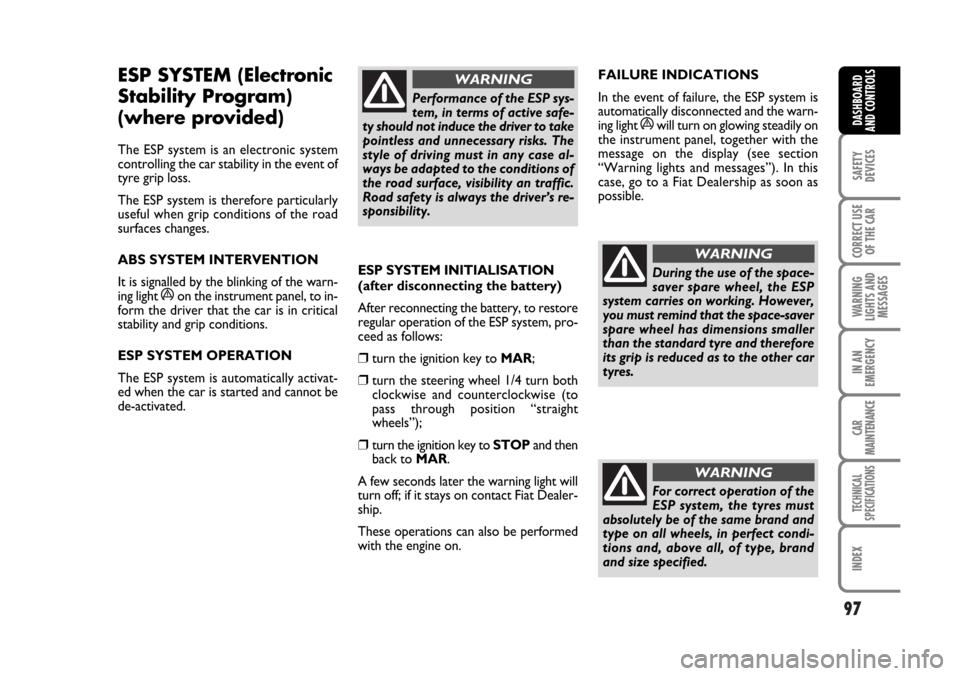
97
SAFETY
DEVICES
CORRECT USE
OF THE CAR
WARNING
LIGHTS AND
MESSAGES
IN AN
EMERGENCY
CAR
MAINTENANCE
TECHNICAL
SPECIFICATIONS
INDEX
DASHBOARD
AND CONTROLS
ESP SYSTEM (Electronic
Stability Program)
(where provided)
The ESP system is an electronic system
controlling the car stability in the event of
tyre grip loss.
The ESP system is therefore particularly
useful when grip conditions of the road
surfaces changes.
ABS SYSTEM INTERVENTION
It is signalled by the blinking of the warn-
ing light
áon the instrument panel, to in-
form the driver that the car is in critical
stability and grip conditions.
ESP SYSTEM OPERATION
The ESP system is automatically activat-
ed when the car is started and cannot be
de-activated.FAILURE INDICATIONS
In the event of failure, the ESP system is
automatically disconnected and the warn-
ing light
áwill turn on glowing steadily on
the instrument panel, together with the
message on the display (see section
“Warning lights and messages”). In this
case, go to a Fiat Dealership as soon as
possible.
Performance of the ESP sys-
tem, in terms of active safe-
ty should not induce the driver to take
pointless and unnecessary risks. The
style of driving must in any case al-
ways be adapted to the conditions of
the road surface, visibility an traffic.
Road safety is always the driver’s re-
sponsibility.
WARNING
ESP SYSTEM INITIALISATION
(after disconnecting the battery)
After reconnecting the battery, to restore
regular operation of the ESP system, pro-
ceed as follows:
❒turn the ignition key to MAR;
❒turn the steering wheel 1/4 turn both
clockwise and counterclockwise (to
pass through position “straight
wheels”);
❒turn the ignition key to STOPand then
back to MAR.
A few seconds later the warning light will
turn off; if it stays on contact Fiat Dealer-
ship.
These operations can also be performed
with the engine on.
During the use of the space-
saver spare wheel, the ESP
system carries on working. However,
you must remind that the space-saver
spare wheel has dimensions smaller
than the standard tyre and therefore
its grip is reduced as to the other car
tyres.
WARNING
For correct operation of the
ESP system, the tyres must
absolutely be of the same brand and
type on all wheels, in perfect condi-
tions and, above all, of type, brand
and size specified.
WARNING
Page 103 of 274
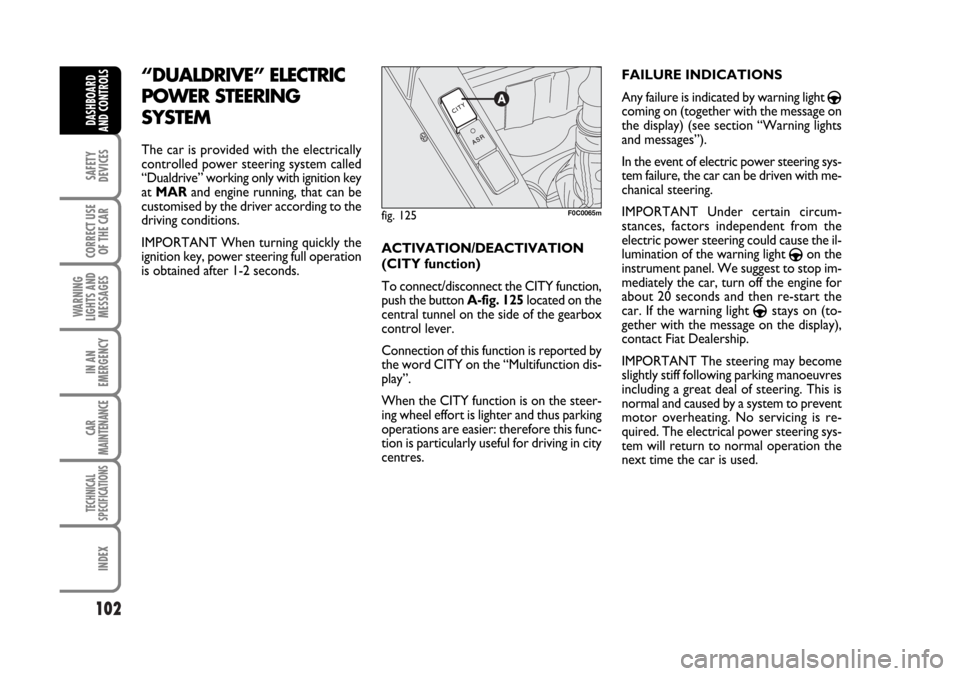
102
SAFETY
DEVICES
CORRECT USE
OF THE CAR
WARNING
LIGHTS AND
MESSAGES
IN AN
EMERGENCY
CAR
MAINTENANCE
TECHNICAL
SPECIFICATIONS
INDEX
DASHBOARD
AND CONTROLS
“DUALDRIVE” ELECTRIC
POWER STEERING
SYSTEM
The car is provided with the electrically
controlled power steering system called
“Dualdrive” working only with ignition key
at MARand engine running, that can be
customised by the driver according to the
driving conditions.
IMPORTANT When turning quickly the
ignition key, power steering full operation
is obtained after 1-2 seconds.ACTIVATION/DEACTIVATION
(CITY function)
To connect/disconnect the CITY function,
push the button A-fig. 125located on the
central tunnel on the side of the gearbox
control lever.
Connection of this function is reported by
the word CITY on the “Multifunction dis-
play”.
When the CITY function is on the steer-
ing wheel effort is lighter and thus parking
operations are easier: therefore this func-
tion is particularly useful for driving in city
centres.FAILURE INDICATIONS
Any failure is indicated by warning light
gcoming on (together with the message on
the display) (see section “Warning lights
and messages”).
In the event of electric power steering sys-
tem failure, the car can be driven with me-
chanical steering.
IMPORTANT Under certain circum-
stances, factors independent from the
electric power steering could cause the il-
lumination of the warning light
gon the
instrument panel. We suggest to stop im-
mediately the car, turn off the engine for
about 20 seconds and then re-start the
car. If the warning light
gstays on (to-
gether with the message on the display),
contact Fiat Dealership.
IMPORTANT The steering may become
slightly stiff following parking manoeuvres
including a great deal of steering. This is
normal and caused by a system to prevent
motor overheating. No servicing is re-
quired. The electrical power steering sys-
tem will return to normal operation the
next time the car is used.
fig. 125F0C0065m
Page 104 of 274
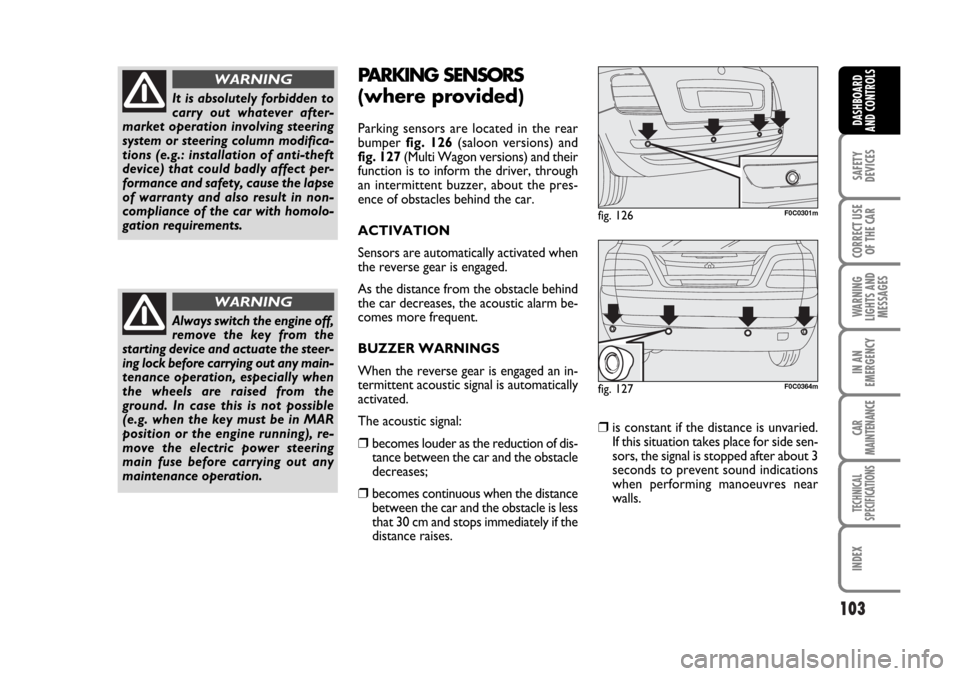
103
SAFETY
DEVICES
CORRECT USE
OF THE CAR
WARNING
LIGHTS AND
MESSAGES
IN AN
EMERGENCY
CAR
MAINTENANCE
TECHNICAL
SPECIFICATIONS
INDEX
DASHBOARD
AND CONTROLS
PARKING SENSORS
(where provided)
Parking sensors are located in the rear
bumper fig. 126(saloon versions) and
fig. 127 (Multi Wagon versions) and their
function is to inform the driver, through
an intermittent buzzer, about the pres-
ence of obstacles behind the car.
ACTIVATION
Sensors are automatically activated when
the reverse gear is engaged.
As the distance from the obstacle behind
the car decreases, the acoustic alarm be-
comes more frequent.
BUZZER WARNINGS
When the reverse gear is engaged an in-
termittent acoustic signal is automatically
activated.
The acoustic signal:
❒becomes louder as the reduction of dis-
tance between the car and the obstacle
decreases;
❒becomes continuous when the distance
between the car and the obstacle is less
that 30 cm and stops immediately if the
distance raises.
❒is constant if the distance is unvaried.
If this situation takes place for side sen-
sors, the signal is stopped after about 3
seconds to prevent sound indications
when performing manoeuvres near
walls.
It is absolutely forbidden to
carry out whatever after-
market operation involving steering
system or steering column modifica-
tions (e.g.: installation of anti-theft
device) that could badly affect per-
formance and safety, cause the lapse
of warranty and also result in non-
compliance of the car with homolo-
gation requirements.
WARNING
Always switch the engine off,
remove the key from the
starting device and actuate the steer-
ing lock before carrying out any main-
tenance operation, especially when
the wheels are raised from the
ground. In case this is not possible
(e.g. when the key must be in MAR
position or the engine running), re-
move the electric power steering
main fuse before carrying out any
maintenance operation.
WARNING
fig. 126F0C0301m
fig. 127F0C0364m
Page 127 of 274
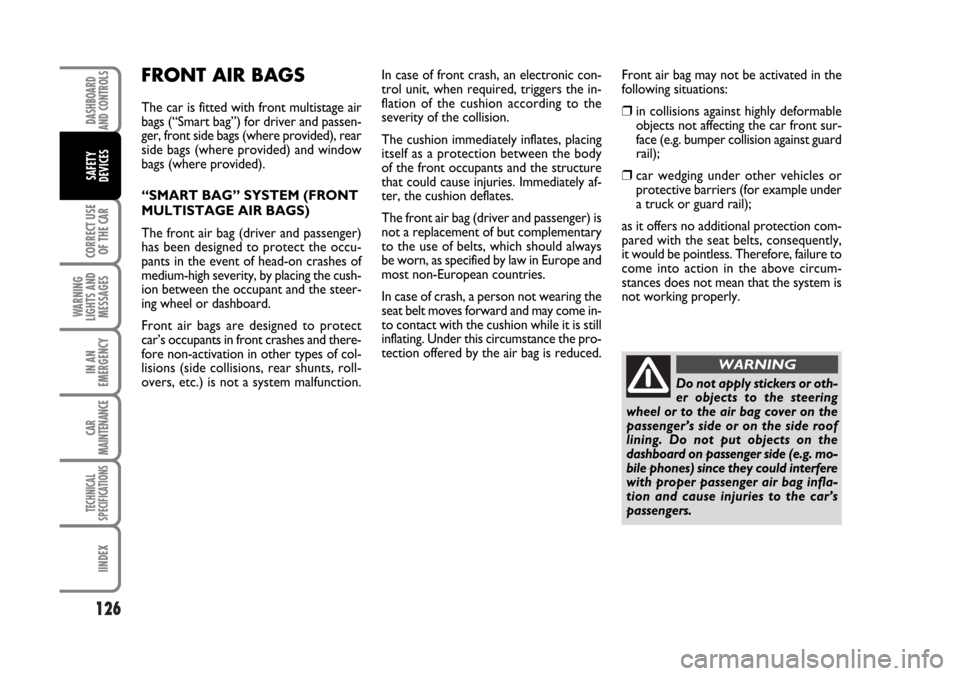
126
CORRECT USE
OF THE CAR
WARNING
LIGHTS AND
MESSAGES
IN AN
EMERGENCY
CAR
MAINTENANCE
TECHNICAL
SPECIFICATIONS
IINDEX
DASHBOARD
AND CONTROLS
SAFETY
DEVICES
FRONT AIR BAGS
The car is fitted with front multistage air
bags (“Smart bag”) for driver and passen-
ger, front side bags (where provided), rear
side bags (where provided) and window
bags (where provided).
“SMART BAG” SYSTEM (FRONT
MULTISTAGE AIR BAGS)
The front air bag (driver and passenger)
has been designed to protect the occu-
pants in the event of head-on crashes of
medium-high severity, by placing the cush-
ion between the occupant and the steer-
ing wheel or dashboard.
Front air bags are designed to protect
car’s occupants in front crashes and there-
fore non-activation in other types of col-
lisions (side collisions, rear shunts, roll-
overs, etc.) is not a system malfunction.In case of front crash, an electronic con-
trol unit, when required, triggers the in-
flation of the cushion according to the
severity of the collision.
The cushion immediately inflates, placing
itself as a protection between the body
of the front occupants and the structure
that could cause injuries. Immediately af-
ter, the cushion deflates.
The front air bag (driver and passenger) is
not a replacement of but complementary
to the use of belts, which should always
be worn, as specified by law in Europe and
most non-European countries.
In case of crash, a person not wearing the
seat belt moves forward and may come in-
to contact with the cushion while it is still
inflating. Under this circumstance the pro-
tection offered by the air bag is reduced.
Do not apply stickers or oth-
er objects to the steering
wheel or to the air bag cover on the
passenger’s side or on the side roof
lining. Do not put objects on the
dashboard on passenger side (e.g. mo-
bile phones) since they could interfere
with proper passenger air bag infla-
tion and cause injuries to the car’s
passengers.
WARNING
Front air bag may not be activated in the
following situations:
❒in collisions against highly deformable
objects not affecting the car front sur-
face (e.g. bumper collision against guard
rail);
❒car wedging under other vehicles or
protective barriers (for example under
a truck or guard rail);
as it offers no additional protection com-
pared with the seat belts, consequently,
it would be pointless. Therefore, failure to
come into action in the above circum-
stances does not mean that the system is
not working properly.
Page 128 of 274
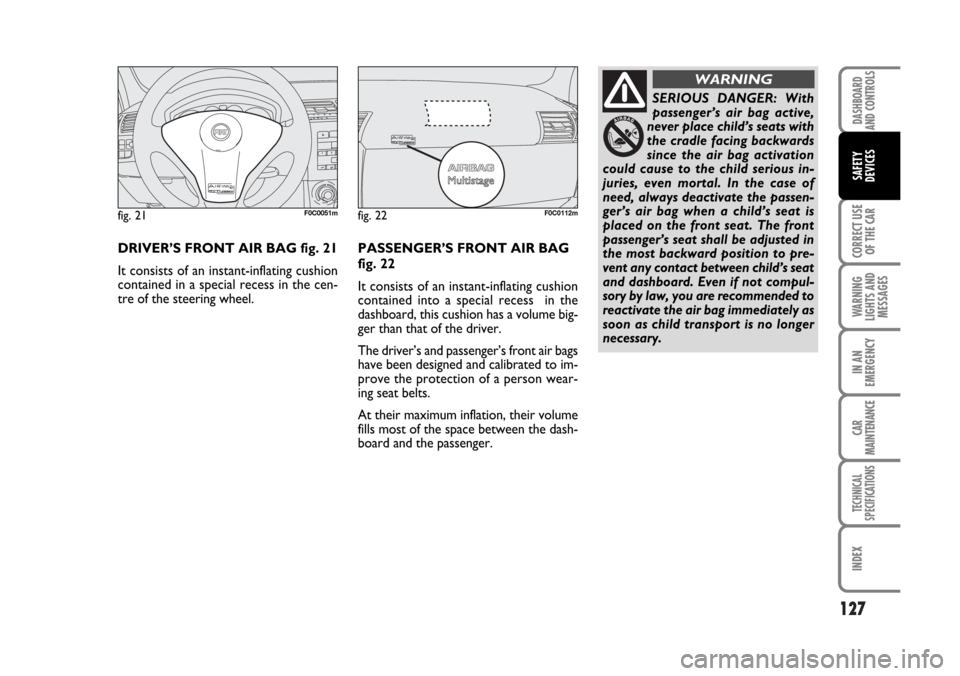
127
CORRECT USE
OF THE CAR
WARNING
LIGHTS AND
MESSAGES
IN AN
EMERGENCY
CAR
MAINTENANCE
TECHNICAL
SPECIFICATIONS
INDEX
DASHBOARD
AND CONTROLS
SAFETY
DEVICES
DRIVER’S FRONT AIR BAG fig. 21
It consists of an instant-inflating cushion
contained in a special recess in the cen-
tre of the steering wheel.PASSENGER’S FRONT AIR BAG
fig. 22
It consists of an instant-inflating cushion
contained into a special recess in the
dashboard, this cushion has a volume big-
ger than that of the driver.
The driver’s and passenger’s front air bags
have been designed and calibrated to im-
prove the protection of a person wear-
ing seat belts.
At their maximum inflation, their volume
fills most of the space between the dash-
board and the passenger.
fig. 21F0C0051mfig. 22F0C0112m
SERIOUS DANGER: With
passenger’s air bag active,
never place child’s seats with
the cradle facing backwards
since the air bag activation
could cause to the child serious in-
juries, even mortal. In the case of
need, always deactivate the passen-
ger’s air bag when a child’s seat is
placed on the front seat. The front
passenger’s seat shall be adjusted in
the most backward position to pre-
vent any contact between child’s seat
and dashboard. Even if not compul-
sory by law, you are recommended to
reactivate the air bag immediately as
soon as child transport is no longer
necessary.
WARNING
Page 134 of 274
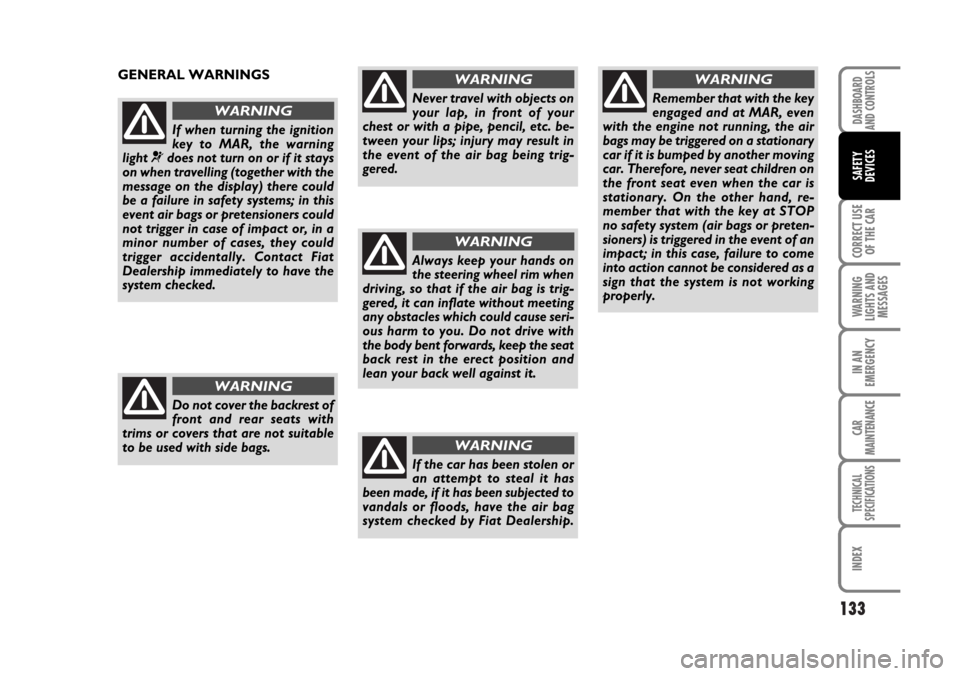
133
CORRECT USE
OF THE CAR
WARNING
LIGHTS AND
MESSAGES
IN AN
EMERGENCY
CAR
MAINTENANCE
TECHNICAL
SPECIFICATIONS
INDEX
DASHBOARD
AND CONTROLS
SAFETY
DEVICES
Remember that with the key
engaged and at MAR, even
with the engine not running, the air
bags may be triggered on a stationary
car if it is bumped by another moving
car. Therefore, never seat children on
the front seat even when the car is
stationary. On the other hand, re-
member that with the key at STOP
no safety system (air bags or preten-
sioners) is triggered in the event of an
impact; in this case, failure to come
into action cannot be considered as a
sign that the system is not working
properly.
WARNINGGENERAL WARNINGS
If when turning the ignition
key to MAR, the warning
light ¬does not turn on or if it stays
on when travelling (together with the
message on the display) there could
be a failure in safety systems; in this
event air bags or pretensioners could
not trigger in case of impact or, in a
minor number of cases, they could
trigger accidentally. Contact Fiat
Dealership immediately to have the
system checked.
WARNING
Do not cover the backrest of
front and rear seats with
trims or covers that are not suitable
to be used with side bags.
WARNING
Never travel with objects on
your lap, in front of your
chest or with a pipe, pencil, etc. be-
tween your lips; injury may result in
the event of the air bag being trig-
gered.
WARNING
Always keep your hands on
the steering wheel rim when
driving, so that if the air bag is trig-
gered, it can inflate without meeting
any obstacles which could cause seri-
ous harm to you. Do not drive with
the body bent forwards, keep the seat
back rest in the erect position and
lean your back well against it.
WARNING
If the car has been stolen or
an attempt to steal it has
been made, if it has been subjected to
vandals or floods, have the air bag
system checked by Fiat Dealership.
WARNING
Page 139 of 274
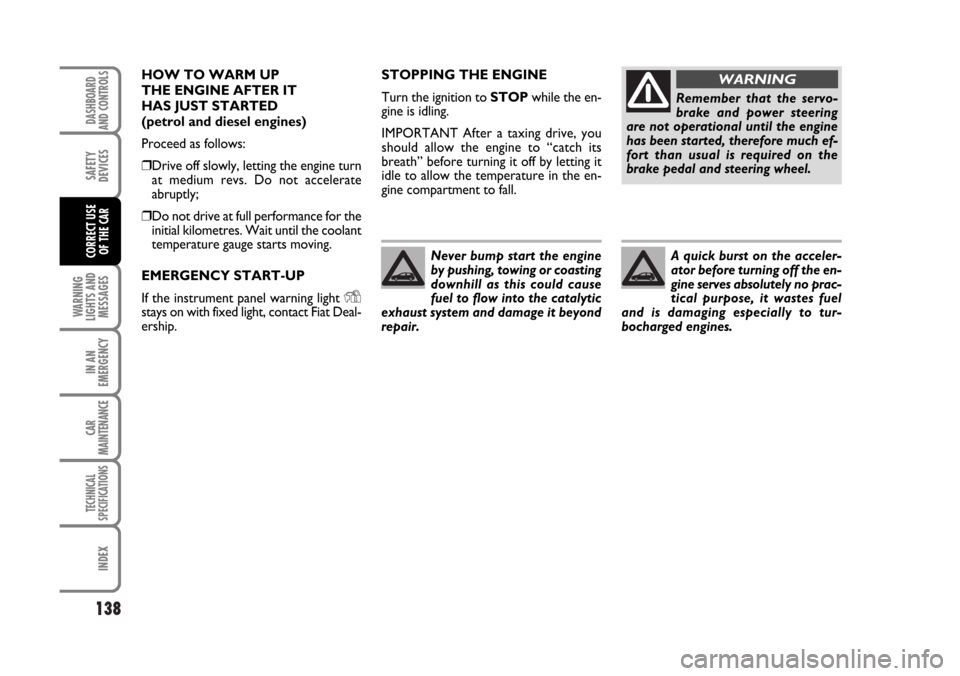
138
WARNING
LIGHTS AND
MESSAGES
IN AN
EMERGENCY
CAR
MAINTENANCE
TECHNICAL
SPECIFICATIONS
INDEX
DASHBOARD
AND CONTROLS
SAFETY
DEVICES
CORRECT USE
OF THE CAR
STOPPING THE ENGINE
Turn the ignition to STOPwhile the en-
gine is idling.
IMPORTANT After a taxing drive, you
should allow the engine to “catch its
breath” before turning it off by letting it
idle to allow the temperature in the en-
gine compartment to fall.
Never bump start the engine
by pushing, towing or coasting
downhill as this could cause
fuel to flow into the catalytic
exhaust system and damage it beyond
repair.
Remember that the servo-
brake and power steering
are not operational until the engine
has been started, therefore much ef-
fort than usual is required on the
brake pedal and steering wheel.
WARNING
A quick burst on the acceler-
ator before turning off the en-
gine serves absolutely no prac-
tical purpose, it wastes fuel
and is damaging especially to tur-
bocharged engines.
HOW TO WARM UP
THE ENGINE AFTER IT
HAS JUST STARTED
(petrol and diesel engines)
Proceed as follows:
❒Drive off slowly, letting the engine turn
at medium revs. Do not accelerate
abruptly;
❒Do not drive at full performance for the
initial kilometres. Wait until the coolant
temperature gauge starts moving.
EMERGENCY START-UP
If the instrument panel warning light
Ystays on with fixed light, contact Fiat Deal-
ership.
Page 142 of 274
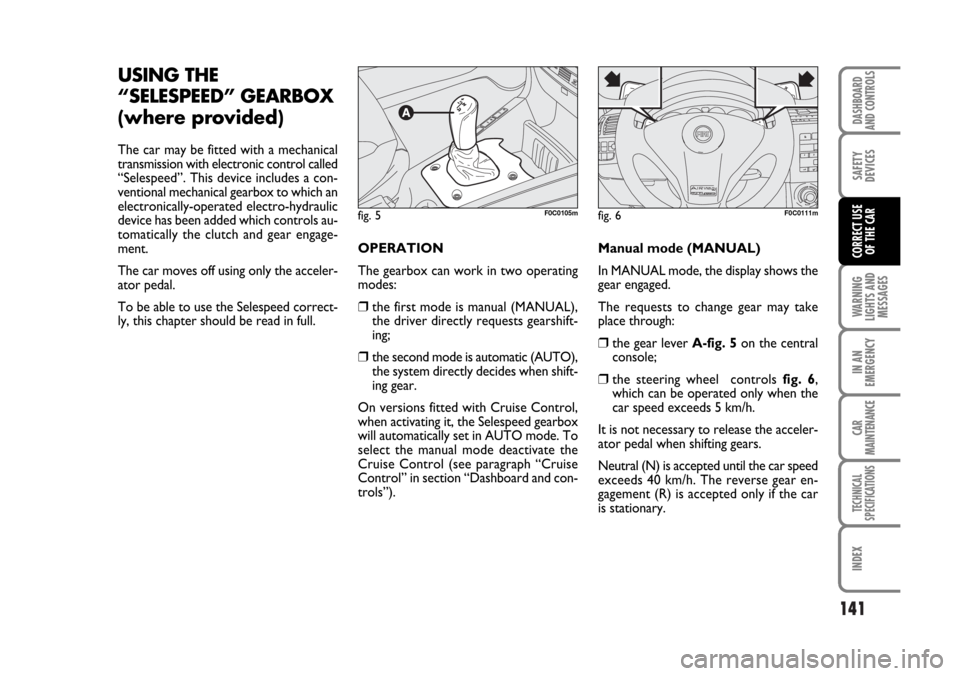
141
WARNING
LIGHTS AND
MESSAGES
IN AN
EMERGENCY
CAR
MAINTENANCE
TECHNICAL
SPECIFICATIONS
INDEX
DASHBOARD
AND CONTROLS
SAFETY
DEVICES
CORRECT USE
OF THE CAR
USING THE
“SELESPEED” GEARBOX
(where provided)
The car may be fitted with a mechanical
transmission with electronic control called
“Selespeed”. This device includes a con-
ventional mechanical gearbox to which an
electronically-operated electro-hydraulic
device has been added which controls au-
tomatically the clutch and gear engage-
ment.
The car moves off using only the acceler-
ator pedal.
To be able to use the Selespeed correct-
ly, this chapter should be read in full. OPERATION
The gearbox can work in two operating
modes:
❒the first mode is manual (MANUAL),
the driver directly requests gearshift-
ing;
❒the second mode is automatic (AUTO),
the system directly decides when shift-
ing gear.
On versions fitted with Cruise Control,
when activating it, the Selespeed gearbox
will automatically set in AUTO mode. To
select the manual mode deactivate the
Cruise Control (see paragraph “Cruise
Control” in section “Dashboard and con-
trols”).Manual mode (MANUAL)
In MANUAL mode, the display shows the
gear engaged.
The requests to change gear may take
place through:❒the gear lever A-fig. 5on the central
console;
❒the steering wheel controls fig. 6,
which can be operated only when the
car speed exceeds 5 km/h.
It is not necessary to release the acceler-
ator pedal when shifting gears.
Neutral (N) is accepted until the car speed
exceeds 40 km/h. The reverse gear en-
gagement (R) is accepted only if the car
is stationary.
fig. 5F0C0105mfig. 6F0C0111m